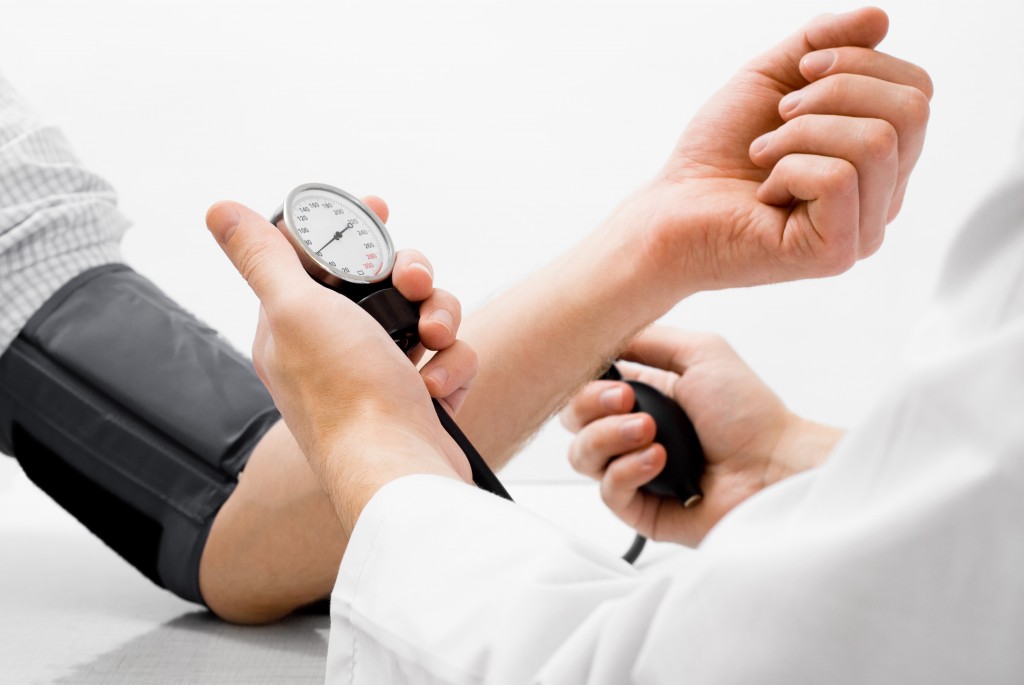 What is High Blood Pressure?
What is High Blood Pressure?
High blood pressure is a major risk factor for a heart attack or stroke. The blood pressure denotes the resistance produced each time the heart beats and sends blood coursing through the arteries. The peak reading of the pressure exerted by this contraction is the systolic pressure. Between beats the heart relaxes, and blood pressure drops. The lowest reading is referred to as the diastolic pressure. A normal blood pressure reading for an adult is: 120 (systolic) / 80 (diastolic). Readings above this level are a major risk factor for heart attack and stroke. High blood pressure readings can be divided into the following levels:
- Prehypertension (120-139/80-89)
- Borderline (120-160/90-94)
- Mild (140-160/95-104)
- Moderate 140-180/105-114)
- Severe (160+/115+)
Borderline to moderate high blood pressure is generally without symptoms. Severe hypertension may be associated with increased sleepiness, confusion, headache, nausea, and vomiting.
What causes High Blood Pressure?
Although medical textbooks state that the cause is unknown in 95% of cases. Genetics definitely play a role, but the cause of high blood pressure is closely related to lifestyle and dietary factors. Some of the important lifestyle factors that may cause high blood pressure include: coffee consumption, alcohol intake, lack of exercise, stress, and smoking. Some of the dietary factors include: obesity; high sodium-to-potassium ratio; low-fiber, high-sugar diet; high saturated-fat and low essential-fatty-acid intake; and a diet low in calcium, magnesium, and vitamin C.
What dietary factors are important in High Blood Pressure?
Achieving ideal body weight is the most important recommendation for those with high blood pressure. However, overweight people who lose even modest amounts of weight experience a reduction in blood pressure. See Weight Loss for more information.
Vegetarians generally have a lower incidence of high blood pressure and other cardiovascular diseases, than non vegetarians. While dietary levels of sodium do not differ significantly between these two groups, a vegetarian’s diet typically contains more potassium, complex carbohydrates, essential fatty acids, fiber, calcium, magnesium, and vitamin C, and less saturated fat and refined carbohydrate, all of which have a favorable influence on blood pressure.
A diet high in sodium and low in potassium is associated with high blood pressure. Conversely, a diet high in potassium and low in sodium can lower blood pressure. Numerous studies have shown that sodium restriction alone does not improve blood pressure control in most people; it must be accompanied by a high potassium intake. Most Americans have a potassium-to-sodium ratio of less than 1:2, meaning they ingest more than twice as much sodium as potassium. Researchers recommend a dietary potassium-to-sodium ratio of greater than 5:1 to maintain health. The easiest way to lower sodium intake is to avoid prepared foods and table salt, and use potassium chloride salt substitutes, such as the popular brands NoSalt® and Nu-Salt®, instead. The best ways to boost potassium levels are to increase the intake of fruits, vegetables, whole grains, and legumes.
Two very large studies have shown quite clearly that diet can be effective in lowering blood pressure. These studies, the “Dietary Approaches to Stop Hypertension” (DASH) tested a diet rich in fruits, vegetables, and low fat dairy foods, and low in saturated and total fat. The DASH diet was also low in cholesterol; high in dietary fiber, potassium, calcium, and magnesium; and moderately high in protein.
The first study showed that a diet rich in fruits, vegetables, and low-fat dairy products can reduce blood pressure in the general population and people with hypertension. The original DASH diet did not require either sodium restriction or weight loss-the two traditional dietary tools to control blood pressure-to be effective. The second study from the DASH research group found that coupling the original DASH diet with sodium restriction is more effective than either dietary manipulation alone. In the first trial, the DASH diet produced a net blood pressure reduction of 11.4 and 5.5 mmHg systolic and diastolic, respectively, in patients with hypertension. In the second trial, sodium intake was also quantified at a “higher” intake of 3,300 mg per day; an “intermediate” intake of 2,400 mg per day; and a “lower” intake of 1,500 mg per day. Compared to the control diet, the DASH diet was associated with a significantly lower systolic blood pressure at each sodium level. The DASH diet with the lower sodium level led to a mean systolic blood pressure that was 7.1 mmHg lower in participants without hypertension, and 11.5 mmHg lower in participants with hypertension. These results are clinically significant and indicate that a sodium intake below the recommended level of 2,400 mg daily can significantly and quickly lower blood pressure.
Special foods for people with high blood pressure include celery; garlic and onions to lower cholesterol; nuts and seeds, or their oils, for their essential fatty acid content; cold-water fish, e.g. salmon and mackerel, or fish oil products concentrated for the omega 3 fatty acids EPA and DHA; green leafy vegetables and sea vegetables for their of calcium and magnesium; whole flaxseeds, whole grains and legumes for their fiber; and foods rich in vitamin C, such as broccoli and citrus fruits.
What nutritional supplements should I take for High Blood Pressure?
Nutritional supplement protocols are given below based upon the response or lack of response to the program as well as the degree of initial high blood pressure.
For Prehypertension (120-139/80-89); Borderline (120-160/90-94) and Mild (140-160/95-104) follow Level 1 Support. For Moderate 140-180/105-114) follow Level 2 Support; and for Severe (160+/115+) follow Level 3 Support. Be sure to work closely with your physician even if you simply have Prehypertension.
Level 1 Support
Foundation Supplements. High potency multiple vitamin and mineral formula; Vitamin D3 2,000-5,000 IU/day; Fish oil, EPA+DHA 1,000 to 3,000 mg/day.
Potassium supplementation can produce significant reductions in blood pressure in hypertensive subjects. Typically, these studies have utilized dosages ranging from 2.5 to 5.0 grams of potassium per day. Significant drops in both systolic and diastolic values have been achieved (e.g., 12 mm and 16 mm, respectively. Potassium supplementation is especially useful in the treatment of high blood pressure in persons over the age of sixty-five. Potassium supplements are available either by prescription or over the counter (OTC). However, the FDA restricts the amount of potassium available in OTC potassium supplements to a mere 99 mg per dose because of problems associated with high-dosage prescription potassium salts. However, so-called salt substitutes, such as the popular brands NoSalt and Nu-Salt, are in fact potassium chloride at a dosage of 530 mg of potassium per one-sixth teaspoon.
Magnesium supplementation has also been shown to lower blood pressure, particularly in patients who are already on high blood pressure medication. Take 150 to 250 mg three to four times daily.
WARNING: People with kidney disease or severe heart disease (such as high-grade atrioventricular block) should not take magnesium or potassium unless under the direct advice of a physician.
Bonito peptides refers to a purified mixture of small peptides (proteins) derived from muscle of the fish bonito (a member of the tuna family). Basically, these peptides work to lower blood pressure by inhibiting ACE (angiotensin converting enzyme). This enzyme converts angiotensin I to angiotensin II, which is a compound that increases both the fluid volume and the degree of constriction of the blood vessels. If we use a garden hose model to illustrate the pressure in your arteries, the formation of angiotensin II would be similar to pinching off the hose while turning up the faucet full blast. By inhibiting the formation of this compound, anti-ACE peptides relax the arterial walls and reduce fluid volume. The bonito peptides exert the strongest inhibition of ACE reported for any naturally, occurring substance available.
Clinical studies have shown anti-ACE peptides from bonito are effective in about two thirds of people with high blood pressure – about the same percentage as many prescription drugs. The degree of blood pressure reduction in these studies was quite significant, typically reducing the systolic by at least 10 mm Hg and the diastolic by 7 mm Hg in people with prehypertension and borderline hypertension. Greater reductions will be seen in people with higher initial blood pressure readings. Dosage: 1,500 mg daily.
Grape Seed Extract (standardized to contain 95% procyanidolic oligomers) has been shown to normalize high blood pressure in patients with initial blood pressure in the range of 150/95 mm Hg in two double-blind clinical trials. Dosage: 300 mg daily.
If after 2 months if there is no change or blood pressure remains above normal, go to Level 2 Support.
Level 2 Support
Choose one or more of the following:
- Berberine – An alkaloid from goldenseal, barberry bark, and Oregon grape root has shown impressive results in lowering blood pressure, as well as improve blood sugar control and blood lipid levels. Take 500 mg before meals three times daily.
- Celery Seed Extract standardized to contain 85% 3-n-butylphthalide (3nB). 3nB is a compound that is unique to celery and is responsible for the characteristic flavor and odor of celery. 3nB was discovered as the active component of celery in response to investigations by researchers seeking to explain some of the medicinal effects of celery including the lowering of blood pressure and the relief of arthritis. 3nB first drew significant scientific attention when researchers at the University of Chicago Medical Center identified it as the factor in celery responsible for the blood pressure lowering effect of celery. The research was prompted by one of the researcher’s father, who after eating a quarter-pound of celery every day for one week observed his blood pressure dropped from 158 over 96 to a normal reading of 118 over 82. Subsequent animal studies found that a very small amount of 3nB lowered blood pressure by 12 to 14% and also lowered cholesterol by about 7%. It appears to have a similar effect in humans at a dosage of 75 to 150 mg twice daily.
- Olive leaf extract has been shown in clinical trials to work as effective as the conventional antihypertensive drug Captopril in lowering blood pressure, but without side effect. Dosage: 500 mg (17% to 23% oleuropein content) twice daily.
- Hibiscus tea or extracts have demonstrated antihypertensive properties in clinical trials. In double-blind studies, hibiscus extract showed similar blood pressure lowering effect to popular antihypertensive drugs. Butunlike the drugs, which carry a significant side effect profile, hibiscus has a 100% tolerability and safety response. Typical reductions in systolic blood pressure are 15-20 mm Hg in subjects with initial readings of 140 mm Hg. Dosage: for the tea, three 240 ml servings/day; for an extract, take enough to supply 10-20 mg anthocyanidins daily.
Coenzyme Q10 (CoQ10) has been shown to lower blood pressure. The dosage is 200 mg daily – make sure to use CoQ10 in a soft gel for enhanced absorption.
If after 2 months if there is no change or blood pressure remains above normal, go to Level 3 Support.
Level 3 Support
If you have severe hypertension or with the natural approach your blood pressure has not dropped below 140/105, you will need to work with a physician to select the most appropriate medication. If a prescription drug is necessary, a calcium channel blockers or ACE inhibitors alone or in combination with a diuretic appear to be the safest when Level 3 Support is required. Follow the supplement recommendations given for Level 2 Support. When satisfactory control over the high blood pressure has been achieved, work with the physician to taper off the medication.
How do I know if the recommendations are working?
You will know if the program is working by monitoring your blood pressure. As a reminder, high blood pressure must not be taken lightly. By keeping your blood pressure in the normal range, you will not only lengthen your life, but you will improve the quality of your life as well. This is especially true if natural measures, rather than drugs, are used to attain proper blood pressure; the drugs carry significant side effects such as fatigue, headaches, and impotence.


